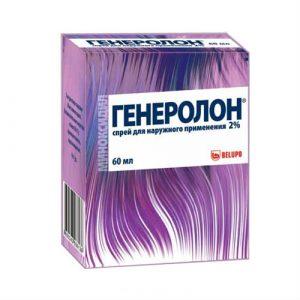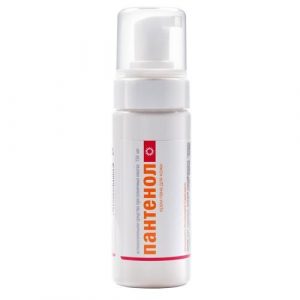Description
Pharmacological action
Pharmacotherapeutic group:
Rash acne treatment
ATX:
D.10.AF51 Clindamycin in combination with other drugs
Pharmacodynamics:
Clindamycin has an antibacterial and microbicidal activity. Lincosamides, such as clindamycin, bind to the 50S subunit of the bacterial ribosome and inhibit the early stages of protein synthesis.
The effect of clindamycin is predominantly bacteriostatic, although – high concentrations may have a slow bactericidal effect against – sensitive strains.
Although clindamycin is inactive in vitro, rapid in vivo hydrolysis converts this compound to an antibacterial active clindamycin.
Clindamycin activity has been demonstrated in clinical studies in the treatment of comedones in patients with acne, while clindamycin is active against most strains of Propionibacteium acnes. Clindamycin in vivo inhibits all tested, strains of Propionibacteium, acnes (minimum inhibitory concentration of 0.4 Ñg / ml). After using clindamycin, the percentage of free fatty acids on the surface of the skin decreases from about 14% to 2%.
Benzoyl peroxide has some keratolytic effect against comedones at all stages of their development. Benzoyl peroxide is a highly lipophilic oxidizing agent that exhibits bactericidal activity against Propionibacteium acnes strains that cause common acne (acne vulgaris). In addition, it is an ebostatic agent that counteracts excessive sebum production associated with acne. The addition of benzoyl peroxide reduces the possibility of clindamycin-resistant microorganisms. There is cross-resistance between clindamycin and lincomycin. The presence of two active ingredients in the gel is more convenient to use compared to monocomponent preparations and contributes to greater patient adherence to treatment.
Pharmacokinetics:
Transdermal absorption of clindamycin is negligible (0.043% of the dose used). The presence of benzoyl peroxide in the drug did not affect the transdermal absorption of clindamycin. Studies with radiolabeling have shown that absorption of benzoyl peroxide through the skin can occur only after it is converted to benzoic acid. Benzoic acid in the form of benzoate is excreted through the kidneys.
Indications
Acne (acne vulgaris) of mild to moderate severity, especially with a predominance of inflammatory skin lesions.
Contraindications
Hypersensitivity to clindamycin, lincomycin, benzoyl peroxide and / or to any of the components of the drug.
Children under 12 years old.
Lactation.
Crohn’s disease, ulcerative colitis, pseudomembranous colitis, including a history of.
Caution:
Indoxil should be used with caution. patients with atopic dermatitis, who may experience increased dry skin, as well as patients with allergic diseases.
Indoxil should be used with caution while taking peripheral muscle relaxants.
Caution is advised to apply Indoxil on sensitive areas of the skin (areas of the skin around the eyes, cervical region).
Use during pregnancy and lactation
Fertility.
There are no contraindications to the use of the drug in women of childbearing age using adequate methods of contraception. However, since clinical studies of the use of the drug in pregnant women have not been conducted, Indoxil should be used with caution in the case when adequate contraceptive measures are not used.
Pregnancy
The safety of using Indoxil in women during pregnancy has not been established, therefore, the drug should be prescribed when the intended benefit for the woman exceeds the potential risk to the fetus.
Preclinical studies have not found evidence of impaired fertility or fetal damage due to clindamycin.
Lactation
There are no restrictions on the use of benzoyl peroxide during breast-feeding. There is no data on the excretion of clindamycin in human breast milk when using Indoxil, but with oral and parenteral use of clindamycin preparations, clindamycin was detected in breast milk. Based on this, the use of Indoxil during lactation is not recommended.
Composition
Active ingredients
Benzoyl peroxide – 66.711
(in terms of anhydrous benzoyl peroxide) – 50.0 mg
Clindamycin phosphate 2 – 12.811
(in terms of clindamycin srdkl ppm – 10 mg 00%
Dimethicone – 0, 10%
Disodium lauryl sulfosuccinate – 0.04%
Disodium edetate – 0.10%
Glycerol – 4.00%
Silicon colloidal dioxide – 0.25%
Poloxamer 182 – 0.20%
Sodium hydroxide –
Purified water – up to 1000 mg
1 – the amount of active substances can be adjusted depending on the purity of a series of substances.
2 – in the production of clindamycin, phosphate is laid with a 2% excess.
Dosage and administration
Adults and adolescents over 12 years of age
Indoxil should be applied once a day in the evening to affected areas after thorough skin cleansing. Frequency – the use can be reduced in the event of an intense inflammatory reaction or excessive dryness of the skin at the site of application.
Treatment with the drug should not exceed 12 weeks of continuous use.
On average, to achieve the full therapeutic effect, it is necessary to use the drug Indoxil for 4-6 weeks.
Side effects
Adverse events are listed below, depending on the anatomical and physiological classification and frequency, occurrence. The frequency of occurrence is determined as follows: very often (> 1/10), often (> 1/100 and <1/10), infrequently, (> 1/1000 and <1/100), rarely (> 1/10000 and <1/1000), very rarely (<1/10000, including individual cases). Frequency categories were formed based on. clinical studies of the drug and post-registration observation. Frequency of occurrence of adverse events From the nervous system Infrequently: paresthesia. On the part of the skin and subcutaneous fat Very often: erythema, peeling, dry skin Often: burning, itching, photosensitivity. Infrequently: aggravation of an acne clinic. Very rare: contact dermatitis. Rarely: allergic reaction (including skin rash, urticaria). According to the post-registration observation, the indicated frequency of adverse events was significantly lower. There are separate reports of cases of pseudomembranous colitis or diarrhea in susceptible patients due to the use of other topical drugs containing clindamycin. With prolonged use of the drug Indoxil, resistance of microorganisms to the drug may develop. As part of the post-registration observation, there have been isolated cases of allergic reactions, which can be sudden and severe. Drug Interactions The simultaneous use of Indoxil and topical medicines containing vitamin A derivatives for the treatment of acne should be avoided. Clindamycin antagonizes erythromycin. There is a potential synergy between clindamycin and gentamicin. It has been established that clindamycin disrupts neuromuscular transmission and, therefore, can enhance the effect of peripheral muscle relaxants. Overdose Given that the drug is intended for external use, an overdose of Indoxil is unlikely. Storage conditions Store at 2-8 ° C. Do not freeze. Opened tube: Store at a temperature not exceeding 25 ° C. Keep out of the reach of children. The Expiration of is 18 months. Open tube: 2 months. Do not use after the expiry date stated on the package. pharmacy terms pharmacy terms Dosage form gel for outdoor use




